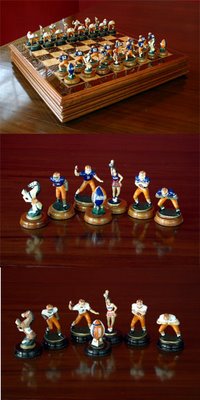Friday, November 17, 2006
Division I college sports are an outrage.
 Even if some fans don't, I understand that they love football for the same reason others love chess — it's a metaphor for life. There is strategy, sometimes you win, sometimes you lose and sometimes it isn't fair. And, once in a while, there is a magical moment when anything is possible.
Even if some fans don't, I understand that they love football for the same reason others love chess — it's a metaphor for life. There is strategy, sometimes you win, sometimes you lose and sometimes it isn't fair. And, once in a while, there is a magical moment when anything is possible.The Ivy League walked away from Division I football in 1981, and nothing has happened to diminish its members' standings as superior academic institutions, and every year more and more students vie for the few spots there, even though their football games are rarely seen on television. Yet, Ivy Leaguers have been bemoaning the loss of their football stature despite all the serious advantages their education gives them, says The New York Times this week:
“It’s depressing when you can walk up to one of those great old Ivy League places 15 minutes before game time and buy a ticket without even waiting in line,” said Joe Restic, who coached at Harvard for 23 seasons beginning in 1971. “It all started with the I-AA classification. Right away the recruits said to us, ‘I don’t want to play with the second-classRead: I got an Ivy League education, but no one wanted to see my football games. Boo-hoo.
citizens.’"
At most Division I universities, football coaches are paid more than the university's president even though many sports programs operate in the red. As far as I'm concerned, that's all you need to know about the NCAA, why it should become an arm of the professional sports leagues, and why it should admit that there is no such thing as a "student-athlete." Students who choose to play sports with the NCAA should be paid well. But, of course, most students wouldn't be able to do that because the idea that a Division I football or basketball player can both study and play at a high level is a mockery wrapped inside a sham.
That's why reforming college sports programs after years of scandals seems to be an exercise in futility because few people are willing to stand up and just admit that big-time college sports and higher education are contradictions in terms.
Murray Sperber, an Indiana University professor regarded as an expert on college athletics, has argued that the proliferation of Division I NCAA sports not only harms "student-athletes," but allows universities to water down their undergraduate programs. In his most famous writing on the subject, he shows that schools outside the Ivy League, such as Emory University — which shunned Division I status — have excelled academically.
Brig Walker, a senior linebacker at Princeton, was a promising player who turned down a scholarship from Oregon State even though Princeton wouldn't give him one to play there.
Division I schools and the NCAA want to have it both ways. But sometimes life isn't fair. And even without Division I as we know it, magic is still possible.“It was an anguishing time because every kid dreams of playing before 100,000 people in a big bowl game,” Walker said in the moments after Princeton upset Yale last weekend. ... “That would have been pretty fun. But I’m happy now with my decision. I guess you can’t have it both ways.”
Comments:
<< Home
Before anyone says anything, I understand that Division I sports programs operate in the red because they support all the other less-loved sports. I still don't care.
I was watching a bit of the Yale v. Harvard game this weekend and they are the smallest statured (and whitest) teams I have ever seen.
I'm just saying...
Post a Comment
I'm just saying...
<< Home
